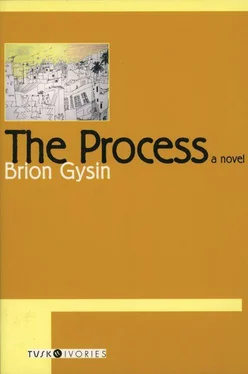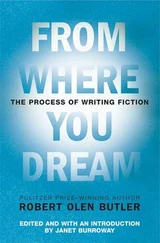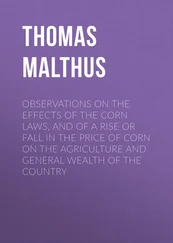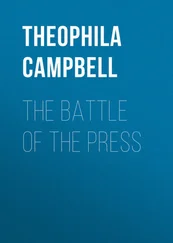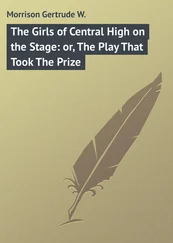Brion Gysin - The Process
Здесь есть возможность читать онлайн «Brion Gysin - The Process» весь текст электронной книги совершенно бесплатно (целиком полную версию без сокращений). В некоторых случаях можно слушать аудио, скачать через торрент в формате fb2 и присутствует краткое содержание. Год выпуска: 2005, ISBN: 2005, Издательство: Overlook, Жанр: Современная проза, на английском языке. Описание произведения, (предисловие) а так же отзывы посетителей доступны на портале библиотеки ЛибКат.
- Название:The Process
- Автор:
- Издательство:Overlook
- Жанр:
- Год:2005
- ISBN:9781468303643
- Рейтинг книги:4 / 5. Голосов: 1
-
Избранное:Добавить в избранное
- Отзывы:
-
Ваша оценка:
- 80
- 1
- 2
- 3
- 4
- 5
The Process: краткое содержание, описание и аннотация
Предлагаем к чтению аннотацию, описание, краткое содержание или предисловие (зависит от того, что написал сам автор книги «The Process»). Если вы не нашли необходимую информацию о книге — напишите в комментариях, мы постараемся отыскать её.
The Process — читать онлайн бесплатно полную книгу (весь текст) целиком
Ниже представлен текст книги, разбитый по страницам. Система сохранения места последней прочитанной страницы, позволяет с удобством читать онлайн бесплатно книгу «The Process», без необходимости каждый раз заново искать на чём Вы остановились. Поставьте закладку, и сможете в любой момент перейти на страницу, на которой закончили чтение.
Интервал:
Закладка:
While at the Beat Hotel, Gysin was working on a collage when he “accidentally” sliced through some pages of newspaper with his Stanley blade. He typed out the cut-up prose, read the results, and found himself rolling on the floor, convulsed in laughter like a man high on nitrous oxide. A period of extensive experimentation with the cutting-up and random reassembly of diverse combinations of texts followed, involving Gregory Corso, Sinclair Beiles, and others in addition to Gysin and Burroughs. Some early results were published in the seminal small-press chapbooks Minutes To Go and Exterminator! “We began to find out a whole lot of things about the real nature of words and writing,” Brion recalled one night when I had my Uher running. “What are words and what are they doing? Where are they going? The cut-up method treats words as the painter treats his paint, raw material with rules and reasons of its own.… Painters and writers of the kind I respect want to be heroes, challenging fate in their lives and in their art. What is fate? Fate is written: Mektoub , in the Arab world, where art has always been nothing but abstract. Mektoub means ‘It is written.’ So … if you want to challenge and change fate …, cut up words. Make them a new world.”
Burroughs’ extensive use of cut-ups in Nova Express, The Ticket That Exploded , and other books made the method highly controversial in the literary world. There was some talk to the effect that Brion was a bad influence, a keef-crazed, razor-wielding, dada-spouting anarchist whose high-art theorizing was corrupting an authentic American voice. In time, cut-ups became enshrined as an alternative strategy for dealing with words, studied and employed by poets and novelists and even playing a part in pop music, as a lyric-writing aid or inspiration for, among others, David Bowie, Iggy Pop, Mick Jagger, and Keith Richards. But Brion wanted no part of any movement or school. From the beginning, he privately urged Burroughs to make more use of his gift for narrative or “representational” prose writing, and while the cut-up experiments form part of the context from which The Process and The Last Museum emerged, neither of Gysin’s novels is a work of abstract or experimental fiction: “I will a round, unvarnished tale deliver.”
What else did Brion do? He was, he liked to point out with amused irony, one of the fathers of sound poetry, among the first artists doing serious work with the tape recorder and the human voice. But Brion did much more with his Uher than that. For him, the tape recorder was as much an artistic medium as painting and writing. He used it to overlay and orchestrate, as a musical composer would, a series of works utilizing the spoken word and permutative techniques, a method of word-manipulation quite distinct from cut-ups. From “I Am that I Am” came “I Am That Am I? Am I That? I Am!” and so on. “Junk is no good baby. No junk is good baby. Is baby good? No junk! No junk baby is good. Junk is goooood, baby … No!” Invited by the BBC to realize these and other works on audio tape, using their studios, he turned his “permutated poems” into symphonies. Another work in this series used as its source material pistol shots recorded at several volume levels and distances from the microphone. Permutating his pistol shot readings like the words in a sentence, using his acute musical ear to divine an appropriate rhythmic context, he came up with a piece that sounds uncannily like the precisely percussive drumming and handclapping of Berbers from the High Atlas of Southern Morocco.
This “Pistol Poem,” far from being an intriguing anomaly, has more to say about who Brion Gysin was, and what it was he did, than any laundry list, however extensive. Looking back over my list, I find that it somehow misses the point. My description of his magic square paintings, for example, omits perhaps the most important detail: the genesis of the idea. Brion’s study of Japanese while in the U.S. Army during World War II, his later study and appreciation of Arabic calligraphy, and his lifelong interest in magic as the “Other Method” for exercising control of matter and knowing space were contributing factors. But here is what happened.
In 1950 Gysin was present at a religious festival outside Tangier, held in what had been in Phoenician times a sacred grove, and very probably a cult center. There he heard strangely riveting music, related to the ecstatic trance music of the Sufi brotherhoods but different; it had a luminous, hieratic quality all its own.
“You know your music when you hear it, one day,” he later wrote of the experience. “You fall into line and dance until you pay the piper.” Later, with the help of the Moroccan painter Hamri, he traced this music back to the village of Jajouka, which perches high on a hilltop in the Rif, just as The Process describes it. What he heard there confirmed his initial impression: “I knew I wanted to hear that music every day for the rest of my life.” What he saw, as the first “foreigner” to visit the village since anyone could remember, utterly astonished him.
In Jajouka, rites and myths from the dawn of Western civilization are preserved, not as faintly remembered traditions, but as a living, integral reality. There Gysin witnessed a ritual he immediately recognized as the Lupercalia, the Rites of Pan, which in Jajouka are not celebrated as folklore but employed as a technology if you will, for bringing the male and female forces in nature into a positive and fruitful equilibrium. In The Process Hansen persuades Hamid to pronounce words from the village’s ritual language and discovers that they are Punic in origin. “Jajouka,” Gysin would say with a gleam in his eye, “that’s a very old scene.”
If the village astonished Gysin, so did the circumstance of its “discovery” by someone so well-equipped to understand what was going on there. Gysin was passionately immerged in the literature and lore of antiquity, and particularly fascinated by the esoteric traditions and Gnosis of early times. He was well-versed in original Greek, Latin and Arabic sources, having built on a first rate education at the Sorbonne and other European universities with a lifetime of reading and study. The fact that he had found a place where the Old Gods still walked the hills and music and magic were still synonymous was, for him, a magical event in itself.
Brion insisted that cut-ups actually cut through the word lines and association lines that moor us in present time, and that sometimes the future leaked through. Sentences formed by cut-ups often prove to be about future events, he said — or perhaps in some cases to determine future events, a rather unsettling proposition, which led Burroughs to postulate that “Writing, when it’s successful, is Making Things Happen.” Well, Jajouka was a similar proposition, though in reverse: the past leaking through into the present. For Jajouka, which has no electricity or running water, is on no map and at the end of no road, exists somehow in its own time, not in our media-saturated century. It constitutes living proof that what we call reality is a perceptual and, socially speaking, a consensual phenomenon. Jajouka’s reality is the magical reality of antiquity. Whether the visitor “believes in” magic or not, in Jajouka he sees magic as method, magic that works.
And here we return to the genesis of Gysin’s magic square paintings. At the urging of Jajouka’s Master Musicians, Brion opened a lavish restaurant in Tangier, with a troupe from Jajouka providing the music. This was in the days before Moroccan independence, when Tangier was a free port, an International Zone — the Interzone of Naked Lunch and of Joy Division’s rock classic Unknown Pleasures . “There were a hundred banks on the Boulevard,” Brion recalled; the restaurant did well. Living in such proximity to the Jajouka musicians, Brion was inevitably curious about their magical practices. “I kept some notes and drawings,” he wrote in Brion Gysin Let The Mice In , “meaning to write a recipe book of magic. My Pan people were furious when they found this out.” There was also a minor falling out over money.
Читать дальшеИнтервал:
Закладка:
Похожие книги на «The Process»
Представляем Вашему вниманию похожие книги на «The Process» списком для выбора. Мы отобрали схожую по названию и смыслу литературу в надежде предоставить читателям больше вариантов отыскать новые, интересные, ещё непрочитанные произведения.
Обсуждение, отзывы о книге «The Process» и просто собственные мнения читателей. Оставьте ваши комментарии, напишите, что Вы думаете о произведении, его смысле или главных героях. Укажите что конкретно понравилось, а что нет, и почему Вы так считаете.
